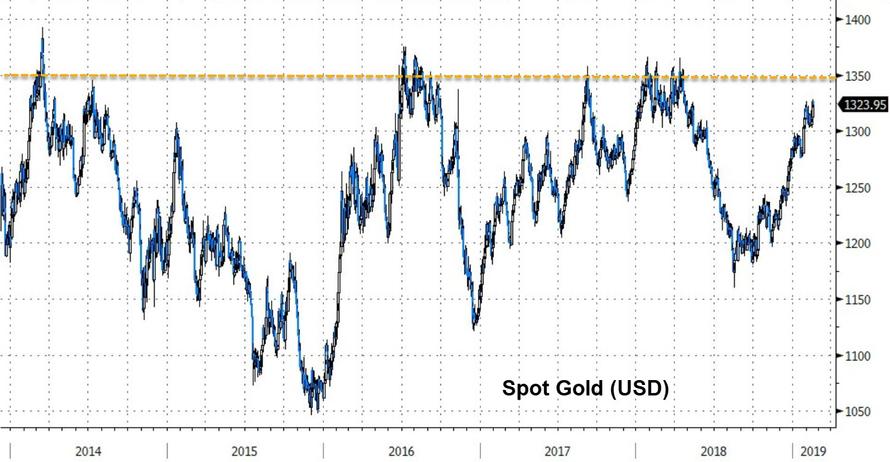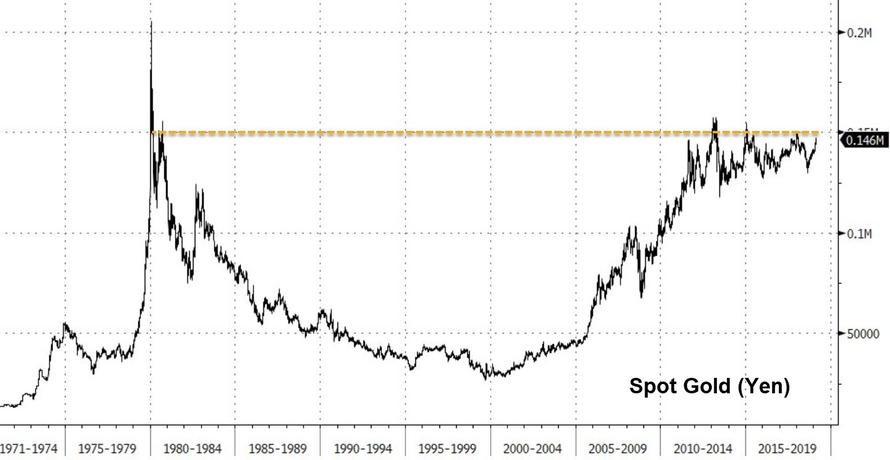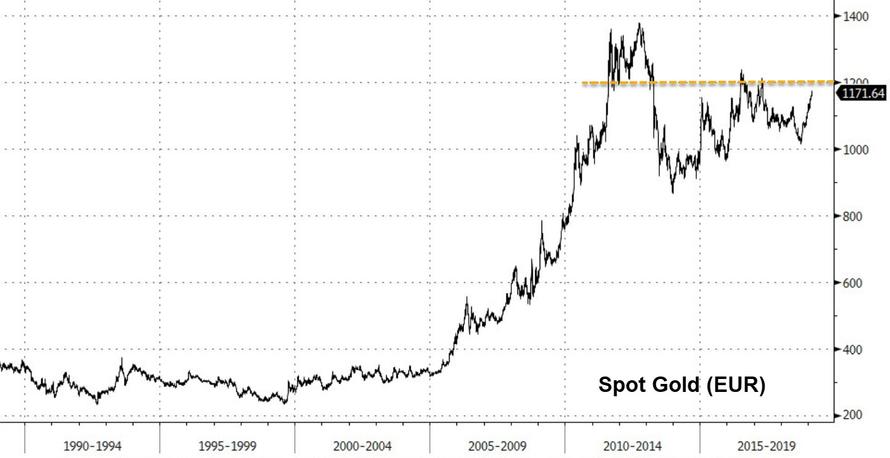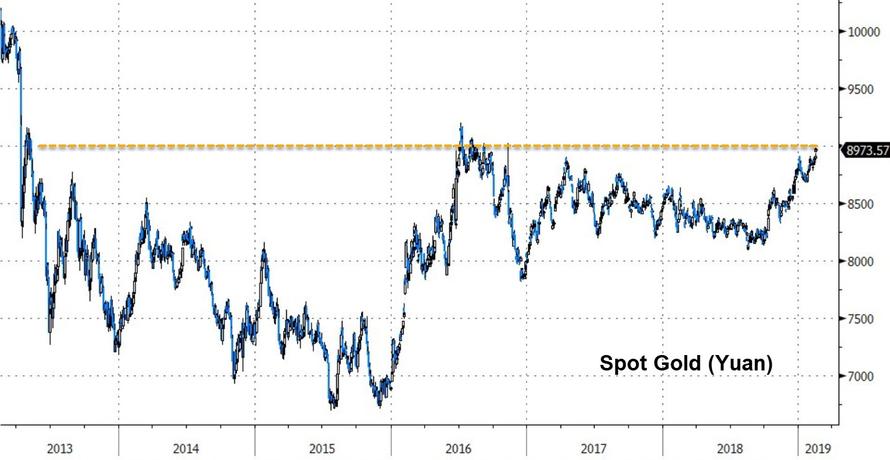The past five years have been baffling for gold bugs. In an environment of massive central bank money creation, rising government deficits and a populist takeover of many countries’ political systems – all of which should be great for safe haven assets – gold has spiked to around $1,350 four times, only to be smacked back down each time. Very demoralizing.
And now it’s gearing up for another try.

It’s obvious that the forces now at work in the world will eventually send terrified capital pouring into sound money like gold and silver — and that, from a technical standpoint, piercing $1,350 resistance should trigger a big, fast move to the next resistance level somewhere in the high $1,400s.
But the “when” part of this story has become an embarrassment, given the number of disappointments the past few years have dished out.
So why risk ridicule by going back there? Because, damn it, $1,350 will be not just pierced but shattered one of these days. And next week could be the week.
I know, Charlie Brown’s football, Einstein’s definition of insanity, Sisyphus’s boulder, some people never learn. But the world really is set up for serious instability, and two new factors have swung in gold’s favor since the last failed attempt.
First, central banks have become fairly aggressive net buyers of gold. Recall that not so long ago central banks as a group were dumping gold on the market in order to “diversify” their reserves into government bonds. Now they’ve apparently seen the error of that approach and are back to buying. See Central bank gold buying hits highest level in half a century.
This is a big, not-especially-price-sensitive new source of demand that might not view $1,350 as a reason to slow down.
Second, the Fed, which had been promising to tighten for years and then actually did tighten for one year was, like the proverbial mule, smacked in the head with a stock market two-by-four. That got its attention, and the tightening has stopped, to be replaced shortly with another, probably much bigger round of easing.
This aligns the US with other major countries, which are already easing. Japan, for instance, is now apparently doubling down on its high-fiscal deficit/NIRP experiment:
Architect of BoJ stimulus calls for big fiscal spending backed by c-bank
(Reuters) – Japan must ramp up fiscal spending with debt bankrolled by the central bank, the Bank of Japan’s former deputy governor Kikuo Iwata said, a controversial proposal that highlights the BOJ’s challenge as it tries to reignite an economy after years of sub-par growth.Iwata, an architect of the BOJ’s massive bond-buying programme dubbed “quantitative and qualitative easing” (QQE), warned that inflation will miss the central bank’s 2 percent target without stronger measures to boost consumption.That means Japan must lean on fiscal policy by ditching this year’s scheduled sales tax hike and committing to boost government spending permanently with money printed by the BOJ, he said.“Inflation won’t hit 2 percent just with the BOJ continuing its current policy. The BOJ doesn’t need to change its policy much now. What needs to change is fiscal policy,” Iwata said.“Fiscal and monetary policies need to work as one, so that more money is spent on fiscal measures and the total money going out to the economy increases as a result,” he told Reuters on Friday. “That’s the only remaining policy option.”Instead of relying on commercial banks to lend more to already cash-rich companies, the BOJ should finance government spending for measures to boost consumption such as payouts or tax breaks for younger-generation households, he said.His proposal resembles the idea of “helicopter money” – a policy where the central bank directly finances government spending by underwriting bonds.

Europe, now descending into what might be the death throes of its post-WWII single market plan, has one and only one chance to salvage it: Aggressive banking integration funded with extremely easy money.
And China, after accounting for 60% of the world’s new credit in the past decade, has decided that that wasn’t enough, and is now creating new credit at an even faster rate:
China’s banks throw open spigots in January, lend record 3.23 trillion yuan
China’s banks made the most new loans on record in January – totaling 3.23 trillion yuan ($477bn) – as policymakers try to jumpstart sluggish investment and prevent a sharper slowdown in the world’s second-largest economy. Chinese banks tend to front-load loans early in the year to get higher-quality customers and win market share. But they have also faced months of pressure from regulators to step up lending, particularly to cash-starved smaller firms. Net new yuan lending last month was far more than expected and eclipsed the last high of 2.9 trillion yuan in January 2018. Analysts… had predicted new loans of 2.8 trillion yuan, more than double the level seen in December.”China’s January new bank loans were 11.4% higher than the previous record from January 2018 – and 15% above estimates. Bank Loans expanded an imprudent $821 billion over the past three months alone, a full 20% above the comparable period from one year ago. Total Bank Loans expanded 13.4% over the past year; 28% in two years; 45% in three years; 91% in five years; and an incredible 323% during the past decade.
Which brings us to the strong dollar. Gold is actually up nicely in most other currencies, but a rising dollar has depressed the metal’s US price. Now, however, with a presidential election in which the choice is between Republicans committed to trillion dollar deficits basically forever and Democrats who are either quasi or overtly socialist, the dollar looks like a sitting duck at these levels.
Add it all up – newly aggressive fiscal and monetary ease, central bank gold buying, and political turmoil – and gold $1,350 is toast. Okay, eventually.


No comments:
Post a Comment
Note: Only a member of this blog may post a comment.